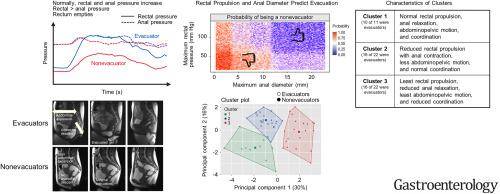Gastroenterology ( IF 29.4 ) Pub Date : 2021-12-22 , DOI: 10.1053/j.gastro.2021.12.257 Brototo Deb 1 , Mayank Sharma 1 , Joel G Fletcher 2 , Sushmitha Grama Srinivasan 1 , Alexandra Chronopoulou 3 , Jun Chen 4 , Kent R Bailey 4 , Kelly J Feuerhak 5 , Adil E Bharucha 5

|
Background & Aims
Diagnostic tests for defecatory disorders (DDs) asynchronously measure anorectal pressures and evacuation and show limited agreement; thus, abdominopelvic-rectoanal coordination in normal defecation and DDs is poorly characterized. We aimed to investigate anorectal pressures, anorectal and abdominal motion, and evacuation simultaneously in healthy and constipated women.
Methods
Abdominal wall and anorectal motion, anorectal pressures, and rectal evacuation were measured simultaneously with supine magnetic resonance defecography and anorectal manometry. Evacuators were defined as those who attained at least 25% rectal evacuation. Supervised (logistic regression and random forest algorithm) and unsupervised (k-means cluster) analyses identified abdominal and anorectal variables that predicted evacuation.
Results
We evaluated 28 healthy and 26 constipated women (evacuators comprised 19 healthy participants and 8 patients). Defecation was initiated by abdominal wall expansion that was coordinated with anorectal descent, increased rectal and anal pressure, and then anal relaxation and rectal evacuation. Compared with evacuators, nonevacuators had lower anal diameters during simulated defecation, rectal pressure, anorectal junction descent, and abdominopelvic-rectoanal coordination (P < .05). Unsupervised cluster analysis identified 3 clusters that were associated with evacuator status (P < .01), that is, 10 evacuators (83%), 16 evacuators (73%), and 1 evacuator (5%) in clusters 1, 2, and 3, respectively. Each cluster had distinct characteristics (eg, maximum abdominosacral distance, rectal pressure, anorectal junction descent, anal diameter) and correlates that were more (clusters 1–2) or less (cluster 3) conducive to evacuation. Cluster 2 had 16 evacuators (73%) and intermediate characteristics (eg, lower anal resting pressure and relaxation during evacuation; P < .05).
Conclusions
Women with DDs and a modest proportion of healthy women had specific patterns of anorectal dysfunction, including inadequate rectal pressurization, anal relaxation, and abdominopelvic-rectoanal coordination. These observations may guide individualized therapy for DDs in the future.
中文翻译:

排便障碍患者的直肠压力不足以及放松和腹盆协调不足
背景与目标
排便障碍 (DD) 的诊断测试异步测量肛门直肠压力和排空,并且显示出有限的一致性;因此,正常排便和 DD 中的腹盆腔-直肠肛门协调的特征很差。我们的目的是同时调查健康和便秘女性的肛门直肠压力、肛门直肠和腹部运动以及排便。
方法
腹壁和肛门直肠运动、肛门直肠压力和直肠排空通过仰卧磁共振排粪造影和肛门直肠测压法同时测量。清空者被定义为那些达到至少 25% 直肠清空的人。监督(逻辑回归和随机森林算法)和无监督(k-均值聚类)分析确定了预测疏散的腹部和肛门直肠变量。
结果
我们评估了 28 名健康女性和 26 名便秘女性(排便器包括 19 名健康参与者和 8 名患者)。排便由腹壁扩张开始,与肛门直肠下降、直肠和肛门压力增加相协调,然后是肛门松弛和直肠排空。与排便者相比,非排便者在模拟排便、直肠压力、肛门直肠交界处下降和腹盆-直肠肛门协调过程中的肛门直径较小 ( P < .05)。无监督聚类分析确定了 3 个与疏散器状态相关的聚类 ( P< .01),即集群 1、2 和 3 中分别有 10 个疏散器 (83%)、16 个疏散器 (73%) 和 1 个疏散器 (5%)。每个集群都有不同的特征(例如,最大腹骶距离、直肠压力、肛门直肠交界处下降、肛门直径)和更多(集群 1-2)或更少(集群 3)有助于疏散的相关性。聚类 2 有 16 个排空器 (73%) 和中间特征(例如,排空时肛门静息压较低和松弛;P < .05)。
结论
患有 DD 的女性和适度比例的健康女性具有特定模式的肛门直肠功能障碍,包括直肠加压不足、肛门松弛和腹盆直肠肛门协调。这些观察结果可能会指导未来 DD 的个体化治疗。



























 京公网安备 11010802027423号
京公网安备 11010802027423号